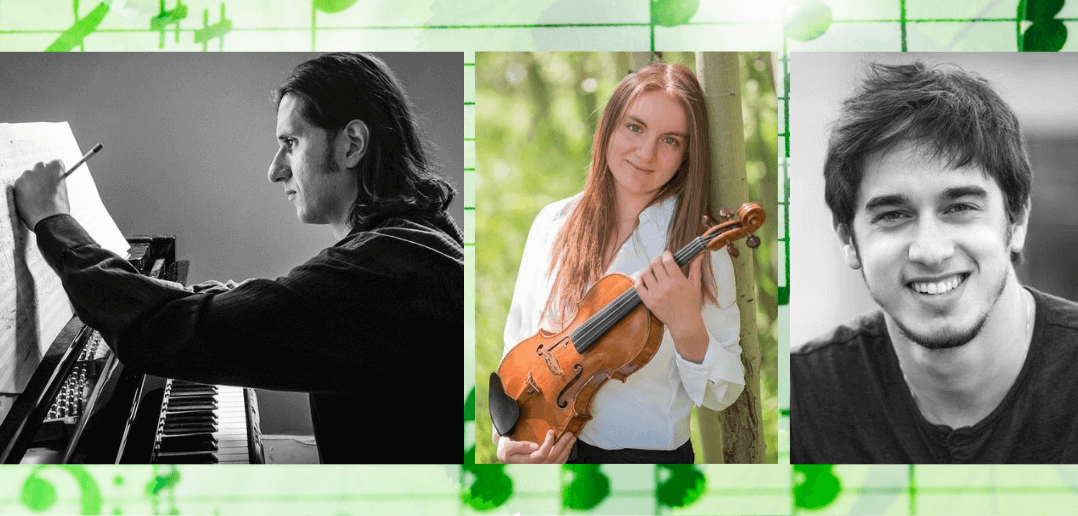On May 12, Brooklyn Music School (126 St. Felix Street) presented a new concert titled “New Music in New York,” featuring new original pieces of contemporary music that focus on peace and the environment—including “Dissolve, O my Heart” by Missy Mazzoli, “Peace” by Jessie Montgomery, and “Lyrica Nova, Op.59 No.3” by Ukrainian composer Sergei Bortkiewicz (1877-1952). The concert also marked the U.S. premiere of “The Condor and Woodpecker Sonata” by celebrated composer Leonardo Le San. The four pieces were performed by Juilliard School alumni Leerone Hakami (violin) and Shay Slusky (piano).
The free concert, open to the public as an in-person event, was also live streamed on BMS’s social media platforms—garnering a wider audience outside the Fort Greene neighborhood.
“It is a gift in my book to have an audience in person at a live concert and to extend the invitation to anyone around the world that would like to tune in and join this program where these amazing artists worked so hard to put that program together,” Le San said. “And this was my first concert stepping out in person and showing my face because every other concert I’ve been a part of has been virtual, long distance, and live streamed. It was a wonderful feeling … like a Renaissance moment.”
Behind the Scenes with the Major Players
Inspired by the large condor bird who travels from Argentina to the mountains of Colombia, Le San says “The Condor and Woodpecker Sonata” is a “love letter to the environment.” He began writing the piece in 2020 and completed it last year before working with Hakami and Slusky to turn the idea into a reality.
While the first bird character serves more as a satire character, mocking the incoming human machine, the second character is a befriending hybrid bird that expresses sorrow and grief about environmental conditions and for the bird’s habitat. The third movement of the piece introduces the woodpecker and represents the way in which the three birds communicate their concerns about the human’s presence in their world, to express Le San’s environmental empathy.
During an intimate post-concert Q&A in the BMS theater space, Le San thanked Hakami for “her virtuosity and musicality” and Slutsky for his “amazing dexterity to tackle the Toccata,” as well as the BMS community and the other featured composers for making the concert a reality and those in attendance for showing their support. He also noted that his collaboration with the two young artists was “unbelievable”—in a positive way—as they all developed and expressed their own voices for the piece throughout the entire three movements.
“It was very important, for me, that they were each allowed to have a voice, and I think it came true. They championed the piece and that was a huge success for me as a composer,” Le San said. “When I saw the audience during their performances, I felt the energy. That energy was really circulating, and I think we were all energized in just not taking one second for granted and just being fully present every second of the concert.”
“The contrast between the [four] pieces, I think, really brought out a wide range of what we do as musicians,” Hakami said before turning her attention to Le San during the Q&A. “It was fun to put that [The Condor and Woodpecker Sonata] together and find the different birds [musically], asking ‘What’s the machine [sound] like? What’s the bird [sound] like?’”
“We enjoyed working on Leonardo’s piece a lot and enjoyed a lot of the dialogue that me and Leerone had—like Leonardo said [regarding] the ‘human versus the machine,’” Slutsky added. “We really felt that, and it was a pleasure to work on this kind of work.”
BMS Student Mentor Director Dr. Michelle Lie noted how one of her youngest students, age 7, attended the concert with his father. “He said that it was his second ever live concert he attended [and] he was particularly taken by the violin performance as he studies violin currently,” Dr. Lie noted. “Musicians inspire each other and others [and] I think my student is definitely ready for his next lesson.”
BMS Executive Director Brian Adamczyk, who emceed the evening and moderated the Q&A, emphasized the importance of holding this new type of event for both the school and larger community. “We offer different types of performing arts programming at BMS and classical music is certainly one of them. But I can’t say that this organization historically has done a lot of new music, classical genre premieres, or special events,” he said. “We know that fans of this type of music exist out there and, so, I think this was a moment to start building a new audience and to take a first stab in creating an opportunity for that type of music to be performed properly in a theatrical setting.”
“I think the talkback feature at the end was a rare opportunity to see the composer right after a piece is played, ask him questions and hear so thoroughly … all the stages of how a piece comes to fruition and how it’s performed in the end. That doesn’t happen every day,” Adamczyk added. “We love doing things like this and we want to keep doing things like this.”
The performance is still available to watch online on BMS’s YouTube channel (search “New Music In New York l Brooklyn Music School”) and will be shown in Colombia where the condor is a very important symbol. “This is very much a global fight … to save our environment, and this is what we do through music,” Le San said.









